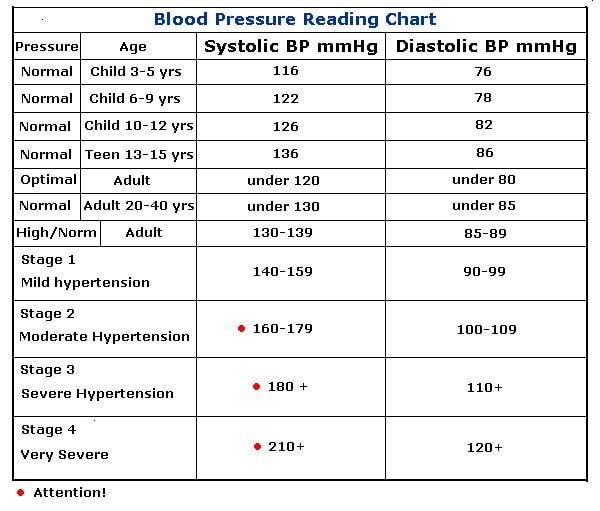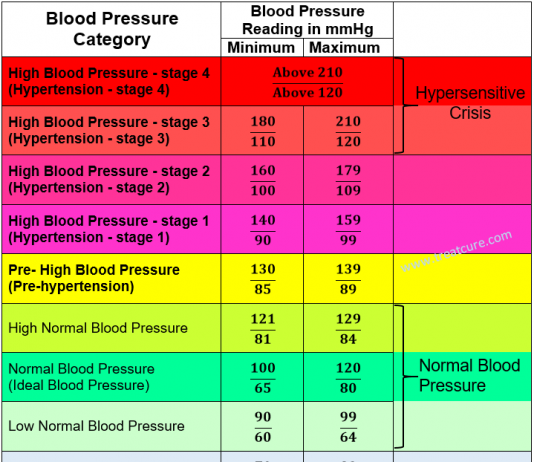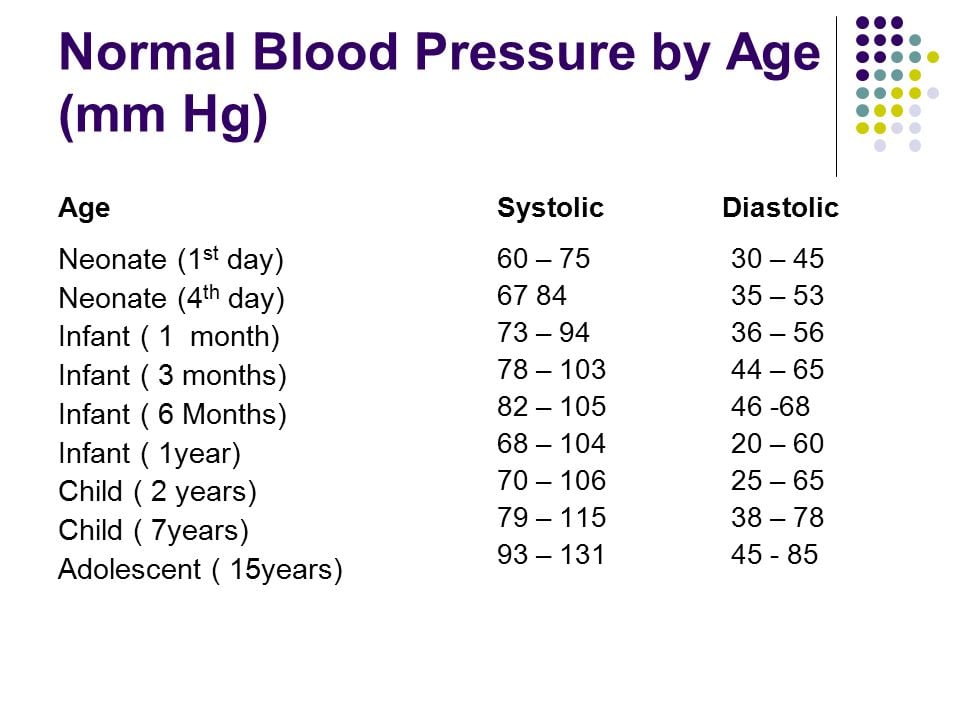How Is A Child’s Blood Pressure Checked
A child’s blood pressure should be checked once a year at their annual exam starting at the age of 3. Your child should sit comfortably in a chair with their feet supported and their arm level with their heart. Your child’s physician or nurse will use a stethoscope and a hand-inflated arm cuff to check their blood pressure.
If a child has a health condition that increases their risk for high blood pressure, such as obesity or kidney disease, their blood pressure will be checked at every doctor visit. If a child’s blood pressure is high at a well-child visit, their blood pressure will also be checked more frequently.
Your child’s pediatrician will track trends in blood pressure over time, not just the initial screening, to accurately identify a diagnosis of hypertension.
How To Help Your Child With High Blood Pressure
Help your child control high blood pressure by following the doctor’s plan carefully. In addition, you can take these steps.
- Make changes to diet and exercise a family affair. Everyone in the family will benefit from these healthy changes.
- Make sure your child has their blood pressure checked as often as recommended by your child’s doctor.
By working with your health specialist to develop a comprehensive health plan, you can help your child control high blood pressure — and enjoy many healthy years ahead.
American Academy of Family Physicians. “High Blood Pressure: Things You Can Do to Help Lower Yours.”
Mayo Clinic: “High blood pressure and children: Watch your child’s weight.”
Mayo Clinic: “How being black affects your blood pressure: A healthy lifestyle is important regardless of skin color.”
National Heart, Lung, and Blood Institute: “The Fourth Report on the Diagnosis, Evaluation, and Treatment of High Blood Pressure in Children and Adolescents.”
National Heart, Lung, and Blood Institute: “Your Guide to Lowering High Blood Pressure: What Are High Blood Pressure and Prehypertension?” U.S. Department of Health and Human Services: “The Surgeon General’s Call to Action to Prevent and Decrease Overweight and Obesity: Overweight in Children and Adolescents.”
WebMD Medical Reference: “High Blood Pressure ,” “How adrenaline regulates blood pressure.”
What Do Blood Pressure Numbers Mean
Blood pressure readings are composed of two numbersfor example, 120/80 mm Hg.
The top number measures the pressure in your arteries when your heart beats. The bottom number measures the pressure in your arteries between each heart beat.
The standard unit of measure, mm Hg, stands for “millimeters of mercury.” Mercury pressure gauges have been replaced with electronic pressure gauges, but the abbreviation is still used.
Recommended Reading: Do Onions Lower Blood Pressure
Signs And Symptoms Of High Blood Pressure
High blood pressure may not have any symptoms and so hypertension has been labeled “the silent killer.” Longstanding high blood pressure can lead to multiple complications including heart attack, kidney disease, or stroke.
Some people experience symptoms with their high blood pressure. These symptoms include:
- Headache
- The Feeling of pulsations in the neck or head
- Nausea
High Blood Pressure In Kids And Teens

Too many kids and teens have high blood pressure and other risk factors for heart disease and stroke. Using the updated 2017 American Academy of Pediatrics Clinical Practice Guidelineexternal icon, a CDC study shows that about 1 in 25 youth ages 12 to 19 have hypertension, and 1 in 10 has elevated blood pressure . High blood pressure is more common in youth with obesity.
High blood pressure in youth is linked to health problems later in life. The good news is that you can both help prevent high blood pressure and manage it.
Recommended Reading: Does Hot Sauce Cause High Blood Pressure
From Age 12 Upward A Measurement Of 120/80 Or Lower Is Ideal
Your doctor can use detailed tables to determine more precisely if your childs blood pressure is normal, borderline or high.
The majority of children and teens we see with elevated blood pressure are overweight. For these patients, treatment consists of lifestyle changes that include a doctor-approved diet and physical activity plan. Increased cardiovascular exercise, and a diet low in salt and rich in fruits, vegetables, grains and low-fat dairy has been shown to lower blood pressure. For pre-pubescent children, were not so much trying to achieve weight loss as to help kids grow into their weight. For about 1-2 percent of our patients who have sustained high blood pressure at multiple doctor visits, we prescribe medication along with lifestyle modifications.
What Is High Blood Pressure
High blood pressure means that there is higher than normal pressure inside the arteries either during systole , or during diastole .
-
If the pressure is high during the pumping phase , then the first number recorded with a blood pressure reading will be high.
-
If the pressure is high during the relaxation phase , then the second number recorded will be high.
High blood pressure is also called hypertension.
Recommended Reading: Onions And Blood Pressure
Can Children Have High Blood Pressure
While a majority of the conversation about high blood pressure centers on adults, children of all ages, from birth to teens, can have high blood pressure. Just like high blood pressure in adults, there are often no symptoms and early diagnosis and treatment are key.
The American Heart Association recommends that all children have yearly blood pressure measurements in order to allow for early detection and intervention.
Normal Bp Range For Adults By Age
| Age Group | |
|---|---|
| 134 | 87 |
Understanding the normal BP range with age can help the doctor and you to estimate your cardiovascular health. Blood pressure levels can fluctuate significantly from one reading to the next and it is important to remember that just one abnormally high reading does not signify that you have high blood pressure. Doctors usually use an average of multiple blood pressure readings taken over a period of several days to arrive at a diagnosis of high blood pressure.
Read Also: Onion Blood Pressure
Hypertension Or High Blood Pressure
- What is the definition of HTN?
- High blood pressure is defined as average systolic BP and/or diastolic BP > /= 95th percentile for age, gender and height on more than 3 occasions.
- Pre-hypertension is defined as SBP and/or DBP between 90th and 95th percentile.
- For adolescents, BP readings > /= 120/80 are considered to be pre-hypertensive.
What Is The Normal Blood Pressure Range
As mentioned earlier, blood pressure increases with age, beginning from infancy to older adulthood. Since most healthy babies and children are typically not at risk for blood pressure problems, most doctors do not check their blood pressure routinely. But, the normal BP range for all adults, regardless of their age, is considered to be lesser than 120/80.
Don’t Miss: Omron Bp785 Calibration
When To Call Your Doctor
A hypertensive crisisdefined as blood pressure above 180/120 mm Hgrequires immediate medical attention. Call 911 if you are also experiencing symptoms such as chest pain, back pain, shortness of breath, difficulty speaking, a change in vision, weakness, or numbness.
Can Primary Hypertension Be Prevented

Pediatricians are making great efforts to prevent obesity and stem the tide of problems that accompany it. We believe that promoting healthy lifestyle choices will help combat this trend and will go a long way towards preventing primary hypertension in children .
Some things are being donenutritional information is being made more readily available, theres one push to provide healthy options in schools and another to remove soft drinks from thembut still, it often comes down to families making the right decisions. We are dedicated to educating families to assist with appropriate dietary and activity choices to improve overall health and reduce the risk of hypertension.
Also Check: Vodka Blood Pressure
Normal Blood Pressure In Girls
Below is a sampling of normal blood pressure ranges for girls:
- Normal blood pressure in 1-year-old girls ranges from 84 to 88 for systolic pressure, and 41 to 45 for diastolic pressure.
- For 6-year-old girls, normal systolic pressure ranges from 92 to 97, while the 50th percentile for diastolic blood pressure falls in the 54 to 58 range.
- Normal blood pressure in 12-year-old girls ranges from 102 to 108 systolic pressure over 61 to 65 diastolic pressure.
What About Medications
In deciding what blood pressure medications are best for a child with CKD, the doctor will consider:
- The type of kidney disease the child has
- The childs age and size
- The childs ability to swallow a pill.
There are many blood pressure medicines available. Many of them have been tested on children. Among these, your childs doctor may prescribe a type of blood pressure pill called an angiotensin converting enzyme inhibitor or an angiotensin receptor blocker . Some studies have suggested that these medications may help to protect kidney function. If your child has salt and water retention, diuretics may also be prescribed. Other types of blood pressure medications, such as beta-blockers, clonidine and calcium channel blockers, may also be chosen as the first line medication to be used in combination with the other medications. Most children with high blood pressure and CKD will require more than one medication. The dose of any medication your child receives must be adjusted for the childs age and weight.
You May Like: Is High Blood Pressure Heart Disease
What Is Blood Pressure
Blood pressure, measured with a blood pressure cuff and stethoscope by a nurse or other health care provider, is the force of the blood pushing against the artery walls.
Two numbers are recorded when measuring blood pressure:
-
The higher number, or systolic pressure, refers to the highest pressure inside the artery. It occurs when the heart contracts and pumps blood into the body.
-
The lower number, or diastolic pressure, refers to the lowest pressure inside the artery. It occurs when the heart relaxes and fills with blood.
Each time the heart beats, it pumps blood into the arteries, resulting in the highest blood pressure, the systolic pressure, as the heart contracts, and the lowest blood pressure, the diastolic pressure, as the heart relaxes.
Both the systolic and diastolic pressures are recorded as “mm Hg” . This recording represents how high the mercury column is raised by the pressure of the blood.
What Complications Are Associated With Hypertension
While kids with hypertension are unlikely to have heart attacks and strokes, it still has significant risks. Hypertension causes changes in the structures of the blood vessels and heart. Since hypertension in children has historically been understudied, there isnt a lot of data about exactly what these changes mean. But we do know that in adults, hypertension increases the chance of complications in the heart, blood vessels, and kidneys. Theres also compelling evidence that some of these changes are seen in children with high blood pressure.
These changes affect:
Blood vesselshigh blood pressure can damage blood vessels throughout the body, which makes it harder for organs to work efficiently.
Kidneysif the blood vessels in the kidneys are damaged, they may stop removing waste and extra fluid from the body. This extra fluid can raise blood pressure even more.
Other organsif left untreated, hypertension makes it harder for blood to reach many different parts of the body, including the eyes and the brain, and can lead to blindness and strokes.
Read Also: Onion And Blood Pressure
When Is The Blood Pressure Too High
Blood pressures vary depending on the age of your child, as well as according to height and weight, and the gender of your child. Generally, blood pressure is low in infancy, and rises slowly as children age. Boys’ blood pressures are slightly higher than girls’ are, and taller people generally have higher blood pressures than short people do.
For example, an infant may have a quite normal blood pressure of 80/45 mm Hg, while that value in an adult is considered low. A teenager may have an acceptable blood pressure of 110/70 mm Hg, but that value would be of concern in a toddler.
The National Heart, Lung, and Blood Institute has prepared a series of age- and gender-specific blood pressure measurement tables for children ages 3 through 17 years, based on percentiles. A range of blood pressure values is given based on how old and how tall your child is. According to the tables, if your child has a blood pressure that is higher than 90 to 95 percent of other boys or girls his or her age and height, then he or she may have high blood pressure.
Again, many factors, including emotions, can affect blood pressure. Readings that are high compared to the values on the table may need to be investigated further by your child’s doctor.
The prevalence of hypertension and obesity in children age 8 to 17 has increased in all racial and ethnic groups since 2002.
Ambulatory Blood Pressure Monitor
If your childs blood pressure is higher than normal during more than one checkup, the doctor may recommend using an ambulatory blood pressure monitor. This small, portable device allows you to monitor your childs blood pressure at home. The monitor is attached to an inflatable cuff, worn on the arm, wrist, or finger. It records a childs blood pressure every 20 to 60 minutes for a 24-hour period.
Ambulatory blood pressure monitors are sometimes used to measure blood pressure in children who become anxious during visits to the doctor, which can temporarily increase blood pressure. They can also be used to provide information on changes in a childs blood pressure at various times of day or to monitor blood pressure in children at risk for kidney damage.
Also Check: Spicy Food High Blood Pressure
Average Blood Pressure By Age
As you get older, your blood vessels tend to become stiffer and plaque can build up in them, which can raise your blood pressure. If your blood pressure becomes too high, you’re at a greater risk for heart disease, strokes, and more.
In 2015, the average blood pressure worldwide was 127/79 mm Hg in men, and 122/77 mm Hg in women, according to a study analysis published in Lancet.
When researchers for the National Center for Health Statistics looked at average blood pressure in U.S. adults between 2001 and 2008, the average reading was 122/71 mm Hg. The breakout was 124/72 mm Hg for men, and 121/70 mm Hg in women. It rose by age and was significantly higher in Black people.
The researchers found the following breakdown by age, sex, and race or ethnicity:
| Blood Pressure by Age |
|---|
As the population ages and life expectancy increases, high blood pressure is becoming more common.
Key Points To Remember

- High blood pressure is common in children with CKD.
- High blood pressure increases the chance that kidney disease will get worse and that heart and vascular disease will develop.
- If your child has CKD, its important to have the childs blood pressure checked.
- Blood pressure should be measured with a cuff that is the right size for the child.
- Normal blood pressure is lower in children. To determine whether your childs blood pressure is high, the doctor will compare his/her reading with charts that list normal ranges for children based on gender, age and size.
- A doctor who specializes in treating CKD and high blood pressure in children should be involved in your childs care.
- Treatment for high blood pressure may include taking medications and making lifestyle changes, such as following a healthy diet, losing weight and exercising regularly. Cutting back on salt may also be recommended.
- The dose of any medication prescribed for your child should be adjusted for the childs age and size.
If you would like more information, please contact us.
You May Like: How To Get Diastolic Blood Pressure Down
Blood Pressure In Teens
Blood pressure is reported as 2 numbers, such as 120/80. The top reading is the systolic pressure, which represents the pressure the heart exerts when it contracts. The bottom number is termed diastolic, which represents the pressure when the heart relaxes. While abnormal blood pressure levels in adults often gets more attention, elevated blood pressure, or hypertension, is a growing health problem in children and adolescents. Sometimes the cause of hypertension is unknown, but it is more likely to occur if other family members have high blood pressure, and can be related to obesity or kidney disease. Achieving normal or healthy blood pressure readings is the goal, and teens should have their blood pressure checked at every doctor visit.
How Is Blood Pressure Measured
Blood pressure is measured in millimeters of mercury . A typical normal blood pressure in an adult is 120/80 mm Hg, or “120 over 80.” The top number refers to the pressure when the heart is pushing blood out through the arteries . The bottom number refers to the pressure when the heart is at restbetween beats .
Its easy to tell whether an adult has hypertension, because theres a standard set of measurements:
- Normal blood pressuresystolic < 120 mmHg and diastolic < 80 mm Hg
- Pre-hypertensionsystolic 120-139 mmHg or diastolic 80-89 mmHg
- Stage 1 hypertensionsystolic 140-159 mmHg or diastolic 90-99 mmHg
- Stage 2 hypertensionsystolic 160 or diastolic 100 mmHg
But its harder with children. Thats because there are no universal cut-offs as there are for adults instead, whether a child has hypertension depends on how his blood pressure compares to his peers .
- Pre-hypertension90th to 95th percentile
- Stage 1 hypertension95th 99th
- Stage 2 hypertensionanything higher than 99th plus 5 mm mercury
Read Also: How To Lower Blood Pressure Immediately